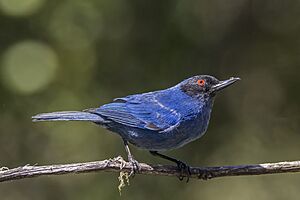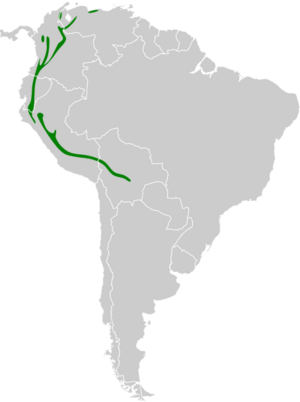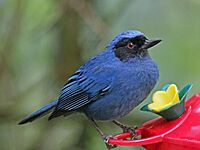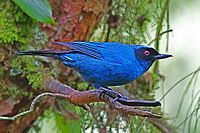Masked flowerpiercer facts for kids
Quick facts for kids Masked flowerpiercer |
|
|---|---|
 |
|
| Diglossa cyanea cyanea, Colombia | |
| Conservation status | |
| Scientific classification | |
| Genus: |
Diglossa
|
| Species: |
cyanea
|
 |
|
| Synonyms | |
|
Diglossopis cyanea Lafresnaye, 1840 |
|
The Masked Flowerpiercer (Diglossa cyanea) is a small, colorful bird that belongs to the tanager family. You can find these birds in the misty mountain forests of South America, including countries like Venezuela, Colombia, Ecuador, Peru, and Bolivia. They are called "flowerpiercers" because they have a special beak with a sharp hook. This hook helps them cut into the bottom of flowers to reach the sweet nectar inside.
Contents
About the Masked Flowerpiercer
The Masked Flowerpiercer grows to be about 15 centimeters (6 inches) long. The adult male is a beautiful deep blue color with a dark mask around its eyes. Its beak is black, large, and points slightly upwards, with that special hook at the tip. The bird's eyes are a bright red.
Male and Female Differences
Female Masked Flowerpiercers look similar to males but are not as brightly colored. Young birds, called juveniles, have reddish-brown eyes.
Unique Bird Songs
These birds have different songs depending on where they live. In the northern parts of their home range, their song sounds like reed pipes ending in a quick twitter. In the southern areas, their song is a series of high-pitched, jangling notes that finish with long "tseee" sounds. These different songs make some scientists wonder if the northern and southern groups might actually be different species.
Where They Live
The Masked Flowerpiercer lives only in the Andes mountains of South America. Their home stretches from Venezuela and Colombia, all the way through Ecuador and Peru, down to Bolivia.
Their Mountain Home
They prefer to live in mountain forests, misty cloud forests, and areas where forests are growing back. You can also spot them at the edges of woodlands. They usually live at high altitudes, between about 2,000 and 3,500 meters (6,500 to 11,500 feet) above sea level.
How They Live
Masked Flowerpiercers are often seen in small groups or with other types of birds. They search for food among the leaves, looking for insects and fruit. They also use their special beaks to poke into flowers.
A Special Way to Eat
One interesting fact is how they interact with a small tree called Axinaea sclerophylla. These trees rely on birds to spread their pollen. When a bird touches the stamens (the parts of the flower that hold pollen), the tree releases a puff of pollen. During one study, the Masked Flowerpiercer was the only bird seen visiting these flowers. Instead of just getting pollen on itself, it would pull off and eat the stamens one by one!
Reproduction and Nests
In Colombia, these birds usually breed between June and September. However, young birds have been seen at different times of the year in other parts of their range. Their nest is shaped like a cup and is built in a bush. They make their nests from mosses and dry grasses, lining them with soft feathers. The eggs are a pale bluish-green with reddish-brown spots and speckles.
Conservation Status
The Masked Flowerpiercer is quite common throughout its very large home range. The International Union for Conservation of Nature (IUCN) has looked at its population and decided that it is a "least concern" species. This means that the bird's population is stable, and it is not currently facing major threats.
Gallery




